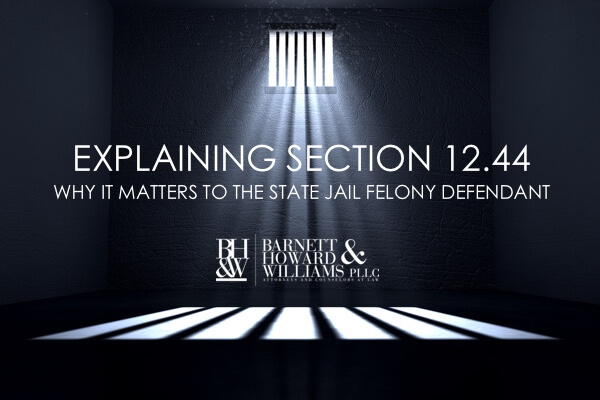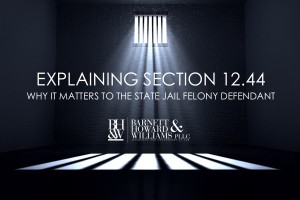
The Importance Between Stacked and Concurrent Sentences
 When a defendant is convicted of multiple crimes at the same trial, his sentences automatically run concurrently, unless there is an order for the sentences to be stacked (i.e. to run consecutively). When sentences are stacked, defendants are required to finish serving the sentence for one offense before they begin serving the sentence for another offense. So, if a defendant is convicted of multiple crimes, especially those with longer sentence ranges, the difference between stacking the sentences or running the sentences concurrently can be huge. Thus, it is very important to know when sentences must run concurrently, when sentences can be stacked, and who makes those decisions.
When a defendant is convicted of multiple crimes at the same trial, his sentences automatically run concurrently, unless there is an order for the sentences to be stacked (i.e. to run consecutively). When sentences are stacked, defendants are required to finish serving the sentence for one offense before they begin serving the sentence for another offense. So, if a defendant is convicted of multiple crimes, especially those with longer sentence ranges, the difference between stacking the sentences or running the sentences concurrently can be huge. Thus, it is very important to know when sentences must run concurrently, when sentences can be stacked, and who makes those decisions.
Who Decides Whether to Stack a Defendant’s Sentences or Run Them Concurrently?
In Texas, defendants have the right to elect to have the jury or a judge assess punishment. However, even when the jury assesses a defendant’s sentences in a case with multiple charges, it is up to the judge of the court to determine whether the sentences will be stacked or whether the sentences will run concurrently.
The trial court’s authority to stack sentences is derived primarily from article 42.08 of the Texas Code of Criminal Procedure. Under this article, when a defendant with multiple convictions is sentenced, the court must include in the subsequent judgment or judgments whether the sentences will run concurrently or consecutively. This general rule allowing stacking or concurrent sentences applies whether the sentences have been imposed or suspended. As a result, the trial court has broad discretion when pronouncing whether the sentences will be stacked or run concurrently. Nevertheless, there are certain occasions when the judge cannot stack a defendant’s sentence.
When is the Judge Prohibited From Stacking a Defendant’s Sentences?
Generally, when a defendant is found guilty of more than one offense arising from the same criminal episode and prosecuted in a single criminal action, the sentences must run concurrently (i.e. if a person is prosecuted in the same trial for DWI and Unlawful Carrying of a Weapon). However, there are exceptions to this rule that will allow for stacking. For example, if a defendant moves to sever his cases that arose from the same criminal episode, he runs the risk of having his sentences stacked. In addition, case law has permitted multiple convictions, arising out of the same criminal episode, for intoxication manslaughter and certain sex offenses under section 3.03(b) of the Texas Penal Code to be stacked.
What Criteria Does the Trial Court Use to Determine Whether to Stack a Defendant’s Sentence?
Trial Courts tend to consider the same factors used for determining the severity of a defendant’s sentence when deciding whether or not to stack sentences. For example, judges may consider:
- whether the crimes and their objectives were predominantly independent of each other;
- whether the crimes involved separate acts of violence or threats of violence;
- whether the crimes were committed at different times or separate places; and
- other aggravating or mitigating factors such as a defendant’s past record.
Are There Certain Circumstances When a Judge is Required to Stack Sentences?
Yes, but only in one scenario. As provided in Article 42.08, if a defendant is sentenced for an offense committed while the defendant was an inmate in TDC and the defendant has not completed the sentence he was serving at the time of the offense, the judge shall order the new sentence be stacked—to begin immediately upon the completion of the defendant’s previous sentence.
Can the Judge Stack a Probation Sentence with a Prison Sentence?
Yes. In Texas, a judge can choose to stack a probation sentence with prison sentence, but the judge must order the confinement sentence to run first and the probation thereafter.
In Conclusion . . .
To determine whether your case involves offenses that may be stacked, you should consult with your attorney. Stacking sentences is rare, but you should still seek proper legal advice when charged with multiple offenses. If you find yourself in this situation and need an attorney, give us a call.


 What happens when someone who illegally enters the country commits a crime? Further, does it matter is that person was previously deported from the United States? Does federal law provide for sentencing enhancements to extend the prison terms for wrongdoers in this position? The answer is yes—and no. Read on to see how the Fifth Circuit Court of Appeals analyzes federal statutes and sentencing guidelines that could support such an enhancement for the defendant, but decides against doing so.
What happens when someone who illegally enters the country commits a crime? Further, does it matter is that person was previously deported from the United States? Does federal law provide for sentencing enhancements to extend the prison terms for wrongdoers in this position? The answer is yes—and no. Read on to see how the Fifth Circuit Court of Appeals analyzes federal statutes and sentencing guidelines that could support such an enhancement for the defendant, but decides against doing so.
 Pantoja v. State
Pantoja v. State
 Our Fort Worth criminal defense attorneys are routinely asked by family and friends of clients charged with State Jail Felony offenses about 12.44(a) and 12.44(b). Although it is sometimes elusive, our attorneys have had success in reducing State Jail Felony cases under Section 12.44. This article will discuss Sections 12.44(a) and 12.44(b) of the Texas Penal Code and explain why they are important to the State Jail Felony defendant.
Our Fort Worth criminal defense attorneys are routinely asked by family and friends of clients charged with State Jail Felony offenses about 12.44(a) and 12.44(b). Although it is sometimes elusive, our attorneys have had success in reducing State Jail Felony cases under Section 12.44. This article will discuss Sections 12.44(a) and 12.44(b) of the Texas Penal Code and explain why they are important to the State Jail Felony defendant.
 The Federal Fifth Circuit Court of Appeals thinks so. See the Court’s opinion in
The Federal Fifth Circuit Court of Appeals thinks so. See the Court’s opinion in 
 The punishment range for a second-degree felony sexual assault is 2-20 years in prison. However, the minimum period of community supervision (i.e. probation) for the same offense is five years. So can a trial court award community supervision if the jury returns a punishment verdict of less than five years? Here’s how this situation played out down in Houston:
The punishment range for a second-degree felony sexual assault is 2-20 years in prison. However, the minimum period of community supervision (i.e. probation) for the same offense is five years. So can a trial court award community supervision if the jury returns a punishment verdict of less than five years? Here’s how this situation played out down in Houston: In a felony DWI case,
In a felony DWI case, 





